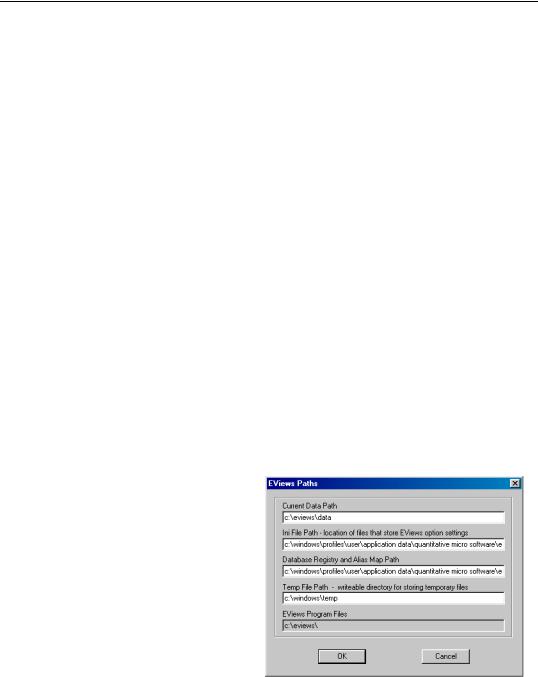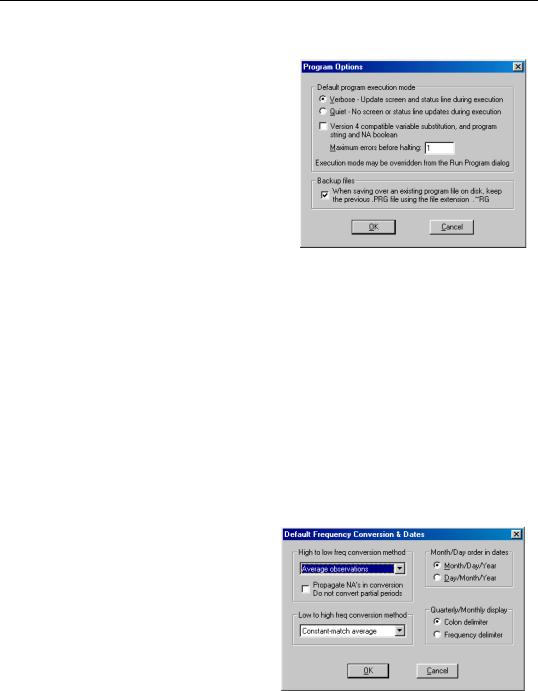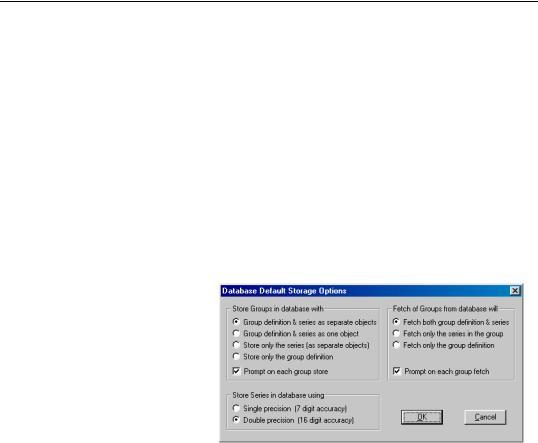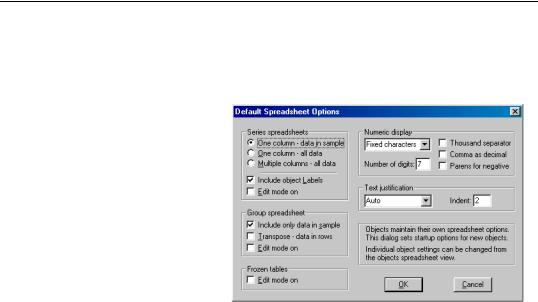
- •Table of Contents
- •What’s New in EViews 5.0
- •What’s New in 5.0
- •Compatibility Notes
- •EViews 5.1 Update Overview
- •Overview of EViews 5.1 New Features
- •Preface
- •Part I. EViews Fundamentals
- •Chapter 1. Introduction
- •What is EViews?
- •Installing and Running EViews
- •Windows Basics
- •The EViews Window
- •Closing EViews
- •Where to Go For Help
- •Chapter 2. A Demonstration
- •Getting Data into EViews
- •Examining the Data
- •Estimating a Regression Model
- •Specification and Hypothesis Tests
- •Modifying the Equation
- •Forecasting from an Estimated Equation
- •Additional Testing
- •Chapter 3. Workfile Basics
- •What is a Workfile?
- •Creating a Workfile
- •The Workfile Window
- •Saving a Workfile
- •Loading a Workfile
- •Multi-page Workfiles
- •Addendum: File Dialog Features
- •Chapter 4. Object Basics
- •What is an Object?
- •Basic Object Operations
- •The Object Window
- •Working with Objects
- •Chapter 5. Basic Data Handling
- •Data Objects
- •Samples
- •Sample Objects
- •Importing Data
- •Exporting Data
- •Frequency Conversion
- •Importing ASCII Text Files
- •Chapter 6. Working with Data
- •Numeric Expressions
- •Series
- •Auto-series
- •Groups
- •Scalars
- •Chapter 7. Working with Data (Advanced)
- •Auto-Updating Series
- •Alpha Series
- •Date Series
- •Value Maps
- •Chapter 8. Series Links
- •Basic Link Concepts
- •Creating a Link
- •Working with Links
- •Chapter 9. Advanced Workfiles
- •Structuring a Workfile
- •Resizing a Workfile
- •Appending to a Workfile
- •Contracting a Workfile
- •Copying from a Workfile
- •Reshaping a Workfile
- •Sorting a Workfile
- •Exporting from a Workfile
- •Chapter 10. EViews Databases
- •Database Overview
- •Database Basics
- •Working with Objects in Databases
- •Database Auto-Series
- •The Database Registry
- •Querying the Database
- •Object Aliases and Illegal Names
- •Maintaining the Database
- •Foreign Format Databases
- •Working with DRIPro Links
- •Part II. Basic Data Analysis
- •Chapter 11. Series
- •Series Views Overview
- •Spreadsheet and Graph Views
- •Descriptive Statistics
- •Tests for Descriptive Stats
- •Distribution Graphs
- •One-Way Tabulation
- •Correlogram
- •Unit Root Test
- •BDS Test
- •Properties
- •Label
- •Series Procs Overview
- •Generate by Equation
- •Resample
- •Seasonal Adjustment
- •Exponential Smoothing
- •Hodrick-Prescott Filter
- •Frequency (Band-Pass) Filter
- •Chapter 12. Groups
- •Group Views Overview
- •Group Members
- •Spreadsheet
- •Dated Data Table
- •Graphs
- •Multiple Graphs
- •Descriptive Statistics
- •Tests of Equality
- •N-Way Tabulation
- •Principal Components
- •Correlations, Covariances, and Correlograms
- •Cross Correlations and Correlograms
- •Cointegration Test
- •Unit Root Test
- •Granger Causality
- •Label
- •Group Procedures Overview
- •Chapter 13. Statistical Graphs from Series and Groups
- •Distribution Graphs of Series
- •Scatter Diagrams with Fit Lines
- •Boxplots
- •Chapter 14. Graphs, Tables, and Text Objects
- •Creating Graphs
- •Modifying Graphs
- •Multiple Graphs
- •Printing Graphs
- •Copying Graphs to the Clipboard
- •Saving Graphs to a File
- •Graph Commands
- •Creating Tables
- •Table Basics
- •Basic Table Customization
- •Customizing Table Cells
- •Copying Tables to the Clipboard
- •Saving Tables to a File
- •Table Commands
- •Text Objects
- •Part III. Basic Single Equation Analysis
- •Chapter 15. Basic Regression
- •Equation Objects
- •Specifying an Equation in EViews
- •Estimating an Equation in EViews
- •Equation Output
- •Working with Equations
- •Estimation Problems
- •Chapter 16. Additional Regression Methods
- •Special Equation Terms
- •Weighted Least Squares
- •Heteroskedasticity and Autocorrelation Consistent Covariances
- •Two-stage Least Squares
- •Nonlinear Least Squares
- •Generalized Method of Moments (GMM)
- •Chapter 17. Time Series Regression
- •Serial Correlation Theory
- •Testing for Serial Correlation
- •Estimating AR Models
- •ARIMA Theory
- •Estimating ARIMA Models
- •ARMA Equation Diagnostics
- •Nonstationary Time Series
- •Unit Root Tests
- •Panel Unit Root Tests
- •Chapter 18. Forecasting from an Equation
- •Forecasting from Equations in EViews
- •An Illustration
- •Forecast Basics
- •Forecasting with ARMA Errors
- •Forecasting from Equations with Expressions
- •Forecasting with Expression and PDL Specifications
- •Chapter 19. Specification and Diagnostic Tests
- •Background
- •Coefficient Tests
- •Residual Tests
- •Specification and Stability Tests
- •Applications
- •Part IV. Advanced Single Equation Analysis
- •Chapter 20. ARCH and GARCH Estimation
- •Basic ARCH Specifications
- •Estimating ARCH Models in EViews
- •Working with ARCH Models
- •Additional ARCH Models
- •Examples
- •Binary Dependent Variable Models
- •Estimating Binary Models in EViews
- •Procedures for Binary Equations
- •Ordered Dependent Variable Models
- •Estimating Ordered Models in EViews
- •Views of Ordered Equations
- •Procedures for Ordered Equations
- •Censored Regression Models
- •Estimating Censored Models in EViews
- •Procedures for Censored Equations
- •Truncated Regression Models
- •Procedures for Truncated Equations
- •Count Models
- •Views of Count Models
- •Procedures for Count Models
- •Demonstrations
- •Technical Notes
- •Chapter 22. The Log Likelihood (LogL) Object
- •Overview
- •Specification
- •Estimation
- •LogL Views
- •LogL Procs
- •Troubleshooting
- •Limitations
- •Examples
- •Part V. Multiple Equation Analysis
- •Chapter 23. System Estimation
- •Background
- •System Estimation Methods
- •How to Create and Specify a System
- •Working With Systems
- •Technical Discussion
- •Vector Autoregressions (VARs)
- •Estimating a VAR in EViews
- •VAR Estimation Output
- •Views and Procs of a VAR
- •Structural (Identified) VARs
- •Cointegration Test
- •Vector Error Correction (VEC) Models
- •A Note on Version Compatibility
- •Chapter 25. State Space Models and the Kalman Filter
- •Background
- •Specifying a State Space Model in EViews
- •Working with the State Space
- •Converting from Version 3 Sspace
- •Technical Discussion
- •Chapter 26. Models
- •Overview
- •An Example Model
- •Building a Model
- •Working with the Model Structure
- •Specifying Scenarios
- •Using Add Factors
- •Solving the Model
- •Working with the Model Data
- •Part VI. Panel and Pooled Data
- •Chapter 27. Pooled Time Series, Cross-Section Data
- •The Pool Workfile
- •The Pool Object
- •Pooled Data
- •Setting up a Pool Workfile
- •Working with Pooled Data
- •Pooled Estimation
- •Chapter 28. Working with Panel Data
- •Structuring a Panel Workfile
- •Panel Workfile Display
- •Panel Workfile Information
- •Working with Panel Data
- •Basic Panel Analysis
- •Chapter 29. Panel Estimation
- •Estimating a Panel Equation
- •Panel Estimation Examples
- •Panel Equation Testing
- •Estimation Background
- •Appendix A. Global Options
- •The Options Menu
- •Print Setup
- •Appendix B. Wildcards
- •Wildcard Expressions
- •Using Wildcard Expressions
- •Source and Destination Patterns
- •Resolving Ambiguities
- •Wildcard versus Pool Identifier
- •Appendix C. Estimation and Solution Options
- •Setting Estimation Options
- •Optimization Algorithms
- •Nonlinear Equation Solution Methods
- •Appendix D. Gradients and Derivatives
- •Gradients
- •Derivatives
- •Appendix E. Information Criteria
- •Definitions
- •Using Information Criteria as a Guide to Model Selection
- •References
- •Index
- •Symbols
- •.DB? files 266
- •.EDB file 262
- •.RTF file 437
- •.WF1 file 62
- •@obsnum
- •Panel
- •@unmaptxt 174
- •~, in backup file name 62, 939
- •Numerics
- •3sls (three-stage least squares) 697, 716
- •Abort key 21
- •ARIMA models 501
- •ASCII
- •file export 115
- •ASCII file
- •See also Unit root tests.
- •Auto-search
- •Auto-series
- •in groups 144
- •Auto-updating series
- •and databases 152
- •Backcast
- •Berndt-Hall-Hall-Hausman (BHHH). See Optimization algorithms.
- •Bias proportion 554
- •fitted index 634
- •Binning option
- •classifications 313, 382
- •Boxplots 409
- •By-group statistics 312, 886, 893
- •coef vector 444
- •Causality
- •Granger's test 389
- •scale factor 649
- •Census X11
- •Census X12 337
- •Chi-square
- •Cholesky factor
- •Classification table
- •Close
- •Coef (coefficient vector)
- •default 444
- •Coefficient
- •Comparison operators
- •Conditional standard deviation
- •graph 610
- •Confidence interval
- •Constant
- •Copy
- •data cut-and-paste 107
- •table to clipboard 437
- •Covariance matrix
- •HAC (Newey-West) 473
- •heteroskedasticity consistent of estimated coefficients 472
- •Create
- •Cross-equation
- •Tukey option 393
- •CUSUM
- •sum of recursive residuals test 589
- •sum of recursive squared residuals test 590
- •Data
- •Database
- •link options 303
- •using auto-updating series with 152
- •Dates
- •Default
- •database 24, 266
- •set directory 71
- •Dependent variable
- •Description
- •Descriptive statistics
- •by group 312
- •group 379
- •individual samples (group) 379
- •Display format
- •Display name
- •Distribution
- •Dummy variables
- •for regression 452
- •lagged dependent variable 495
- •Dynamic forecasting 556
- •Edit
- •See also Unit root tests.
- •Equation
- •create 443
- •store 458
- •Estimation
- •EViews
- •Excel file
- •Excel files
- •Expectation-prediction table
- •Expected dependent variable
- •double 352
- •Export data 114
- •Extreme value
- •binary model 624
- •Fetch
- •File
- •save table to 438
- •Files
- •Fitted index
- •Fitted values
- •Font options
- •Fonts
- •Forecast
- •evaluation 553
- •Foreign data
- •Formula
- •forecast 561
- •Freq
- •DRI database 303
- •F-test
- •for variance equality 321
- •Full information maximum likelihood 698
- •GARCH 601
- •ARCH-M model 603
- •variance factor 668
- •system 716
- •Goodness-of-fit
- •Gradients 963
- •Graph
- •remove elements 423
- •Groups
- •display format 94
- •Groupwise heteroskedasticity 380
- •Help
- •Heteroskedasticity and autocorrelation consistent covariance (HAC) 473
- •History
- •Holt-Winters
- •Hypothesis tests
- •F-test 321
- •Identification
- •Identity
- •Import
- •Import data
- •See also VAR.
- •Index
- •Insert
- •Instruments 474
- •Iteration
- •Iteration option 953
- •in nonlinear least squares 483
- •J-statistic 491
- •J-test 596
- •Kernel
- •bivariate fit 405
- •choice in HAC weighting 704, 718
- •Kernel function
- •Keyboard
- •Kwiatkowski, Phillips, Schmidt, and Shin test 525
- •Label 82
- •Last_update
- •Last_write
- •Latent variable
- •Lead
- •make covariance matrix 643
- •List
- •LM test
- •ARCH 582
- •for binary models 622
- •LOWESS. See also LOESS
- •in ARIMA models 501
- •Mean absolute error 553
- •Metafile
- •Micro TSP
- •recoding 137
- •Models
- •add factors 777, 802
- •solving 804
- •Mouse 18
- •Multicollinearity 460
- •Name
- •Newey-West
- •Nonlinear coefficient restriction
- •Wald test 575
- •weighted two stage 486
- •Normal distribution
- •Numbers
- •chi-square tests 383
- •Object 73
- •Open
- •Option setting
- •Option settings
- •Or operator 98, 133
- •Ordinary residual
- •Panel
- •irregular 214
- •unit root tests 530
- •Paste 83
- •PcGive data 293
- •Polynomial distributed lag
- •Pool
- •Pool (object)
- •PostScript
- •Prediction table
- •Principal components 385
- •Program
- •p-value 569
- •for coefficient t-statistic 450
- •Quiet mode 939
- •RATS data
- •Read 832
- •CUSUM 589
- •Regression
- •Relational operators
- •Remarks
- •database 287
- •Residuals
- •Resize
- •Results
- •RichText Format
- •Robust standard errors
- •Robustness iterations
- •for regression 451
- •with AR specification 500
- •workfile 95
- •Save
- •Seasonal
- •Seasonal graphs 310
- •Select
- •single item 20
- •Serial correlation
- •theory 493
- •Series
- •Smoothing
- •Solve
- •Source
- •Specification test
- •Spreadsheet
- •Standard error
- •Standard error
- •binary models 634
- •Start
- •Starting values
- •Summary statistics
- •for regression variables 451
- •System
- •Table 429
- •font 434
- •Tabulation
- •Template 424
- •Tests. See also Hypothesis tests, Specification test and Goodness of fit.
- •Text file
- •open as workfile 54
- •Type
- •field in database query 282
- •Units
- •Update
- •Valmap
- •find label for value 173
- •find numeric value for label 174
- •Value maps 163
- •estimating 749
- •View
- •Wald test 572
- •nonlinear restriction 575
- •Watson test 323
- •Weighting matrix
- •heteroskedasticity and autocorrelation consistent (HAC) 718
- •kernel options 718
- •White
- •Window
- •Workfile
- •storage defaults 940
- •Write 844
- •XY line
- •Yates' continuity correction 321

Appendix A. Global Options
EViews employs user-specified default settings in many operations. You may, for example, set defaults for everything from how to perform frequency conversion between workfile pages of different frequency, to which font to use in table output, to line color and thickness in graphs, to how to compute derivatives in nonlinear estimation routines.
These default options may, of course, be overridden when actually performing an operation. For example, you may have specified a default conversion of data from monthly to quarterly data by averaging observations, but may choose to use summing when performing a specific conversion. Similarly, you may instruct EViews to use the color red for the first line in newly created graphs, and then change the color in a specific graph.
The Options Menu
The Options menu in the main toolbar allows you to define the default behavior for many of the operations in EViews.
We discuss briefly each of these menu items. In some cases, additional detail is provided in the corresponding sections of the documentation.
Window and Font Options
The window and font options control the display characteristics of various types of EViews output. The settings are divided into broad groupings:
•The Fonts section in the upper left-hand corner of the dialog allows you to change the default font styles and sizes for various sets of windows and objects. Press the button corresponding to the type of object for which you want to change the font and select the new font in the Font dialog. For example, to set the default font face and size to be used in table objects and table views of objects, click on Tables Default, and select the font.

938—Appendix A. Global Options
•Keyboard Focus controls where the keyboard cursor is placed when you change views or windows. As the label suggests, when you select Command Window, the keyboard focus will go to the command window following a change of view. This setting is most useful if you primarily use EViews via the command line. Choosing Active Window will cause the focus to go to the active window following a change of view. You will find this setting useful if you wish to use keystrokes to navigate between and to select items in various windows. Note that whatever the default setting, you may always change the keyboard focus by clicking in the command window, or by clicking in the active window.
•Warn On Close instructs EViews to provide a warning message when you close an untitled object. You may choose to set warnings for various object types. By default, EViews warns you that closing an unnamed object without naming it will cause the object to be deleted. Along with the warning, you will be given an opportunity to name the object. If you turn the warning off, closing an untitled window will automatically delete the object.
•Allow Only One Untitled specifies, for each object type, whether to allow multiple untitled objects to be opened at the same time. If only one is allowed, creating a new untitled object will cause any existing untitled object of that type to be deleted automatically. Setting EViews to allow only one untitled object reduces the number of windows that you will see on your desktop.
If you elect to allow only one untitled object, we strongly recommend that you select Warn on Close. With this option set, you will be given the opportunity to name and save an existing untitled object, otherwise the object will simply be deleted.
File Locations
This dialog allows you to set the default working directory, and the locations of the .INI file, database registry and alias map, and the temp directory.
The dialog also reports, but does not allow you to alter, the location of your EViews executable.
Note that the default working directory may also be changed via the File Open and File Save or File Save As dialogs, or by using the cd command.

The Options Menu—939
Programs
The Program Options dialog specifies whether, by default, EViews runs programs in Verbose mode, listing commands in the status line as they are executed, or whether it uses Quiet mode, which suppresses this information. EViews will run faster in quiet mode since the status line display does not need to be updated.
This default may always be overridden from the Run Program dialog, or by using the option “q” in the run statement, as in:
run(q) myprogram
For details, see Chapter 6, “EViews Programming”, on page 83 of the Command and Programming Reference.
If the checkbox labeled Version 4 compatible variable substitution is selected, EViews will use the variable substitution behavior found in EViews 4 and earlier versions. EViews 5 has changed the way that substitution variables are evaluated in expressions. You may use this checkbox to use Version 4 substitution rules. See “Version 5 Compatibility Notes” on page 93 of the Command and Programming Reference for additional discussion.
In addition, you may use this dialog to specify the maximum number of errors before halting program execution, and whether EViews should keep backup copies of program files when saving over an existing file. The backup copy will have the same name as the file, but with the first character in the extension changed to “~”.
Dates & Frequency Conversion
This dialog allows you to set the default frequency conversion methods for both up and down conversion, and the default method of displaying dates.
The default frequency conversion method tells EViews how to convert data when you move data to lower or higher frequency workfiles. The frequency conversion methods and use of default set-

940—Appendix A. Global Options
tings are discussed in detail in “Frequency Conversion” beginning on page 115.
The default date display controls the format for dates in sample processing, and in workfile and various object views. For daily and weekly data, you can set the default to American (Month/Day/Year) or you may switch to European notation (Day/Month/Year), where the day precedes the month. You may also specify your quarterly or monthly date display to use the Colon delimiter or a Frequency delimiter character based on the workfile frequency (“q” or “m”). The latter has the advantage of displaying dates using an informative delimiter (“1990q1” vs. “1990:1”).
See also “Free-format Conversion Details” on page 149 for related discussion.
Database Registry / Database Storage Defaults
The Database Registry... settings are described in detail in “The Database Registry” on page 275.
You may also control the default behavior of EViews when moving data into and out of databases using the
Database Storage Defaults...
menu item to open the Database Default Storage Options dialog. The dialog controls the behavior of group store and fetch (see “Storing a Group Object” and
“Fetching a Group Object” on page 273), and whether data are stored to databases in single or double precision.
Workfile Storage Defaults
The Workfile Save Options dialog allows you to specify storage precision and compression options for your saved workfiles, and to specify whether or not to create backup workfiles when overwriting existing files on disk.

The Options Menu—941
The Series storage portion of the dialog controls whether series data are stored in saved workfiles in single or double precision. Note that workfiles saved in single precision will be converted to double precision when they are loaded into memory.
In addition, you may elect to save your workfiles in compressed format on disk by checking the Use compression setting. Note that compressed files are not readable by versions of EViews prior to 5.0, and that they do not
save memory when using the workfile, as it is uncompressed when loaded into memory. Compressed workfiles do, however, save disk space.
You should uncheck the Prompt on each Save checkbox to suppress the workfile save dialog on each workfile save.
In addition, you may specify whether EViews should keep backup copies of workfiles when saving over an existing file. If selected, the automatic backup copy will have the same name as the file, but with the first character in the extension changed to “~”.
Estimation Defaults
You can set the global defaults for the maximum number of iterations, convergence criterion, and methods for computing derivatives.
These settings will be used as the default settings in iterative estimation methods for equation, log likelihood, state space, and system objects. Note that previously estimated EViews objects that were estimated with the
previous default settings will be unchanged, unless reestimated. See “Setting Estimation Options” on page 951 for additional details.
When the Display settings option is checked, EViews will produce additional output in the estimation output describing the settings under which estimation was performed.
Graphics Defaults
These options control how a graph appears when it is first created. Most of these options are explained in considerable detail in “Modifying Graphs” beginning on page 416.

942—Appendix A. Global Options
Spreadsheet Defaults
These options control the default spreadsheet view settings of series, group, and table objects. The defaults are set using these option settings when the object is first created.
The left-hand portion of the dialog contains settings for specific objects.
In the upper left-hand corner of the dialog, you may set the display format for Series spreadsheets. You may choose to display the spreadsheet in one or multiple columns, with or without object labels and header information. In addition, you may choose to have edit mode turned on or off by default.
Below this section are the Group spreadsheet options for sample filtering, transposed display, and edit mode.
Frozen tables allows you to modify whether edit mode is on or off by default.
On the right-hand side of the dialog are display settings that apply to all numeric and text spreadsheet displays. You may specify the default Numeric display to be used by new objects. The settings allow you to alter the numeric formatting of cells, the number of digits to be displayed, as well as the characters used as separators and indicators for negative numbers. Similarly, you may choose the default Text justification and Indentation for alphanumeric display.
We emphasize the fact that these display options only apply to newly created series or group objects. If you subsequently alter the defaults, existing objects will continue to use their own settings.
Alpha Truncation
Note that EViews alpha series automatically resize as needed, up to the truncation length.
To modify the alpha series truncation length, select Alpha Truncation... to open the Alpha Truncation Length dialog, and enter the desired length. Subsequent alpha series creation and assignment will use the new truncation length.
